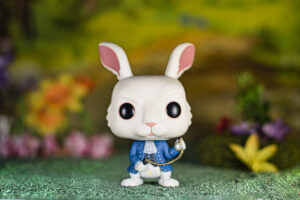The Tale Of The Springtime Hare: The Origin Of The Easter Bunny
12th March 2023
Categorized Under: Myths and Legends from Around the World
Comments (0)
THE TALE OF THE SPRINGTIME HARE: THE ORIGIN OF THE EASTER BUNNY
Springtime brings many symbols of new life and rebirth. From the budding flowers to the chirping birds, it’s a time of renewal and growth. But one of the most beloved symbols of spring is the Easter Bunny. This cute and fluffy creature has become an iconic figure associated with Easter celebrations around the world. But where did this tradition come from? Let’s hop back in time and discover the origins of the Easter Bunny.
The origins of the Easter Bunny can be traced back to ancient pagan rituals. Many ancient cultures celebrated the coming of spring as a time of new life and fertility. The hare was seen as a symbol of fertility and abundance, and its association with springtime made it a popular figure in these celebrations.
As Christianity spread throughout Europe, pagan traditions were often incorporated into Christian holidays. In the 17th and 18th centuries, German immigrants brought the tradition of the Easter Bunny to America. The bunny was seen as a symbol of new life and rebirth, which fit perfectly with the Christian celebration of Easter.
Today, the Easter Bunny has become a beloved figure associated with Easter celebrations around the world. Children eagerly anticipate the arrival of the Easter Bunny and the treats it brings, from chocolate eggs to marshmallow chicks. The Easter Bunny has become a symbol of joy and happiness, representing the new life and growth that comes with the spring season.
Although the Easter Bunny may have pagan origins, it has become a cherished symbol of springtime and Easter celebrations. Its association with new life and rebirth makes it a fitting figure for the Christian celebration of Easter. Whether enjoying chocolate bunnies or hunting for Easter eggs, the Easter Bunny brings joy and happiness to people of all ages. So, let’s all hop into springtime with the Easter Bunny by our side!
German Immigrants Brought Several Easter Bunny Traditions To America, Including:
-
Osterhase: In German folklore, the Osterhase (Easter hare) would lay and decorate eggs, which would be left for children to find on Easter morning. This tradition of egg-laying hares later evolved into the modern-day Easter Bunny in America.
-
Easter Baskets: The Osterhase was said to bring Easter baskets filled with colored eggs and other treats to good children. German immigrants continued this tradition in America, and it remains a popular Easter custom to this day.
-
Easter Egg Hunts: The German tradition of searching for eggs laid by the Osterhase evolved into the modern-day Easter egg hunt. Children would search for hidden eggs, which were often dyed in bright colors.
-
Chocolate Bunnies: In Germany, chocolate makers began creating chocolate bunnies in the early 19th century. This tradition was brought to America by German immigrants and remains a popular Easter treat.
Overall, German immigrants played a significant role in shaping the Easter Bunny traditions that we know and love today in America.
Some Of The Customs Associated With The Easter Holiday, Including The Easter Bunny, May Have Roots In Pre-Christian Pagan Traditions. One of the most significant pagan festivals that took place around the time of the Christian celebration of Easter was the spring equinox. This festival celebrated the return of spring and the lengthening of days after the long, dark winter. Some pagan cultures believed that the hare was a symbol of fertility and new life, and the arrival of spring was often associated with the fertility of animals.
In some pagan cultures, eggs were also associated with fertility and new life, and eggs were often given as gifts during the spring equinox festival. This tradition may have evolved into the Christian tradition of Easter eggs, which are often dyed and given as gifts to celebrate the resurrection of Jesus.
Overall, the Easter Bunny and other Easter customs may have originated from pre-Christian pagan traditions celebrating the arrival of spring and the renewal of life. However, over time, these customs were adapted and incorporated into the Christian celebrations of Easter.
Click here to read Kidsinco’s Myths and Legends from Around the World
Click here to read Kidsinco’s Complete List of Playscripts
Please read our Terms of Use



